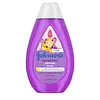What's inside
What's inside
 Key Ingredients
Key Ingredients

 Benefits
Benefits

 Concerns
Concerns

 Ingredients Side-by-side
Ingredients Side-by-side

Water
Skin ConditioningSodium Laureth Sulfate
CleansingCocamidopropyl Betaine
CleansingGlycol Distearate
EmollientGuar Hydroxypropyltrimonium Chloride
Skin ConditioningPropyltrimoniumchloride Acrylamide/Dimethylacrylamide Copolymer
Camellia Seed Oil
Sodium Dilauramidoglutamide Lysine
HumectantSqualane
EmollientRoyal Jelly Extract
Skin ConditioningGlycine Max Seed Extract
Skin ConditioningSorbitol
HumectantPEG-2 Laurate
EmulsifyingSodium Sulfate
Dipropylene Glycol
HumectantLauric Acid
CleansingDimethiconol
EmollientSalicylic Acid
MaskingCitric Acid
BufferingDisodium EDTA
Sodium Lauryl Sulfate
CleansingButylene Glycol
HumectantTocopherol
AntioxidantPhenoxyethanol
PreservativeSodium Benzoate
MaskingAroma
CI 19140
Cosmetic ColorantCI 15985
Cosmetic ColorantWater, Sodium Laureth Sulfate, Cocamidopropyl Betaine, Glycol Distearate, Guar Hydroxypropyltrimonium Chloride, Propyltrimoniumchloride Acrylamide/Dimethylacrylamide Copolymer, Camellia Seed Oil, Sodium Dilauramidoglutamide Lysine, Squalane, Royal Jelly Extract, Glycine Max Seed Extract, Sorbitol, PEG-2 Laurate, Sodium Sulfate, Dipropylene Glycol, Lauric Acid, Dimethiconol, Salicylic Acid, Citric Acid, Disodium EDTA, Sodium Lauryl Sulfate, Butylene Glycol, Tocopherol, Phenoxyethanol, Sodium Benzoate, Aroma, CI 19140, CI 15985
Water
Skin ConditioningCocamidopropyl Betaine
CleansingDecyl Glucoside
CleansingGlycerin
HumectantLauryl Glucoside
CleansingSodium Methyl Cocoyl Taurate
CleansingSodium Cocoyl Isethionate
CleansingPEG-80 Sorbitan Laurate
Sodium Benzoate
MaskingCitric Acid
BufferingPEG-150 Distearate
EmulsifyingGlycol Distearate
EmollientParfum
MaskingDisodium EDTA
Polyquaternium-10
Hydroxypropyl Guar Hydroxypropyltrimonium Chloride
Triticum Vulgare Bran Extract
Skin ConditioningTocopheryl Acetate
AntioxidantPropylene Glycol
HumectantCaprylyl Glycol
Emollient1,2-Hexanediol
Skin ConditioningSodium Chloride
MaskingWater, Cocamidopropyl Betaine, Decyl Glucoside, Glycerin, Lauryl Glucoside, Sodium Methyl Cocoyl Taurate, Sodium Cocoyl Isethionate, PEG-80 Sorbitan Laurate, Sodium Benzoate, Citric Acid, PEG-150 Distearate, Glycol Distearate, Parfum, Disodium EDTA, Polyquaternium-10, Hydroxypropyl Guar Hydroxypropyltrimonium Chloride, Triticum Vulgare Bran Extract, Tocopheryl Acetate, Propylene Glycol, Caprylyl Glycol, 1,2-Hexanediol, Sodium Chloride
 Reviews
Reviews

Ingredients Explained
These ingredients are found in both products.
Ingredients higher up in an ingredient list are typically present in a larger amount.
Citric Acid is an alpha hydroxy acid (AHA) naturally found in citrus fruits like oranges, lemons, and limes.
Like other AHAs, citric acid can exfoliate skin by breaking down the bonds that hold dead skin cells together. This helps reveal smoother and brighter skin underneath.
However, this exfoliating effect only happens at high concentrations (20%) which can be hard to find in cosmetic products.
Due to this, citric acid is usually included in small amounts as a pH adjuster. This helps keep products slightly more acidic and compatible with skin's natural pH.
In skincare formulas, citric acid can:
While it can provide some skin benefits, research shows lactic acid and glycolic acid are generally more effective and less irritating exfoliants.
Most citric acid used in skincare today is made by fermenting sugars (usually from molasses). This synthetic version is identical to the natural citrus form but easier to stabilize and use in formulations.
Read more about some other popular AHA's here:
Learn more about Citric AcidCocamidopropyl Betaine is a fatty acid created by mixing similar compounds in coconut oil and dimethylaminopropylamine, a compound with two amino groups.
This ingredient is a surfactant and cleanser. It helps gather the dirt, pollutants, and other impurities in your skin to be washed away. It also helps thicken a product and make the texture more creamy.
Being created from coconut oil means Cocamidopropyl Betaine is hydrating for the skin.
While Cocamidopropyl Betaine was believed to be an allergen, a study from 2012 disproved this. It found two compounds in unpure Cocamidopropyl Betaine to be the irritants: aminoamide and 3-dimethylaminopropylamine. High-grade and pure Cocamidopropyl Betaine did not induce allergic reactions during this study.
Learn more about Cocamidopropyl BetaineDisodium EDTA plays a role in making products more stable by aiding other preservatives.
It is a chelating agent, meaning it neutralizes metal ions that may be found in a product.
Disodium EDTA is a salt of edetic acid and is found to be safe in cosmetic ingredients.
Learn more about Disodium EDTAGlycol Distearate serves as a pearlizing or opacifying agent in cosmetic products.
It's often included in cleansers and haircare products to give them a lustrous or shimmering appearance.
It is derived from stearic acid, a natural fatty acid commonly found in vegetable oils and animal fats.
Glycol Distearate isn't fungal acne safe.
Learn more about Glycol DistearateSodium Benzoate is a preservative. It's used in both cosmetic and food products to inhibit the growth of mold and bacteria. It is typically produced synthetically.
Both the US FDA and EU Health Committee have approved the use of sodium benzoate. In the US, levels of 0.1% (of the total product) are allowed.
Sodium benzoate works as a preservative by inhibiting the growth of bacteria inside of cells. It prevents the cell from fermenting a type of sugar using an enzyme called phosphofructokinase.
It is the salt of benzoic acid. Foods containing sodium benzoate include soda, salad dressings, condiments, fruit juices, wines, and snack foods.
Studies for using ascorbic acid and sodium benzoate in cosmetics are lacking, especially in skincare routines with multiple steps.
We always recommend speaking with a professional, such as a dermatologist, if you have any concerns.
Learn more about Sodium BenzoateWater. It's the most common cosmetic ingredient of all. You'll usually see it at the top of ingredient lists, meaning that it makes up the largest part of the product.
So why is it so popular? Water most often acts as a solvent - this means that it helps dissolve other ingredients into the formulation.
You'll also recognize water as that liquid we all need to stay alive. If you see this, drink a glass of water. Stay hydrated!
Learn more about Water